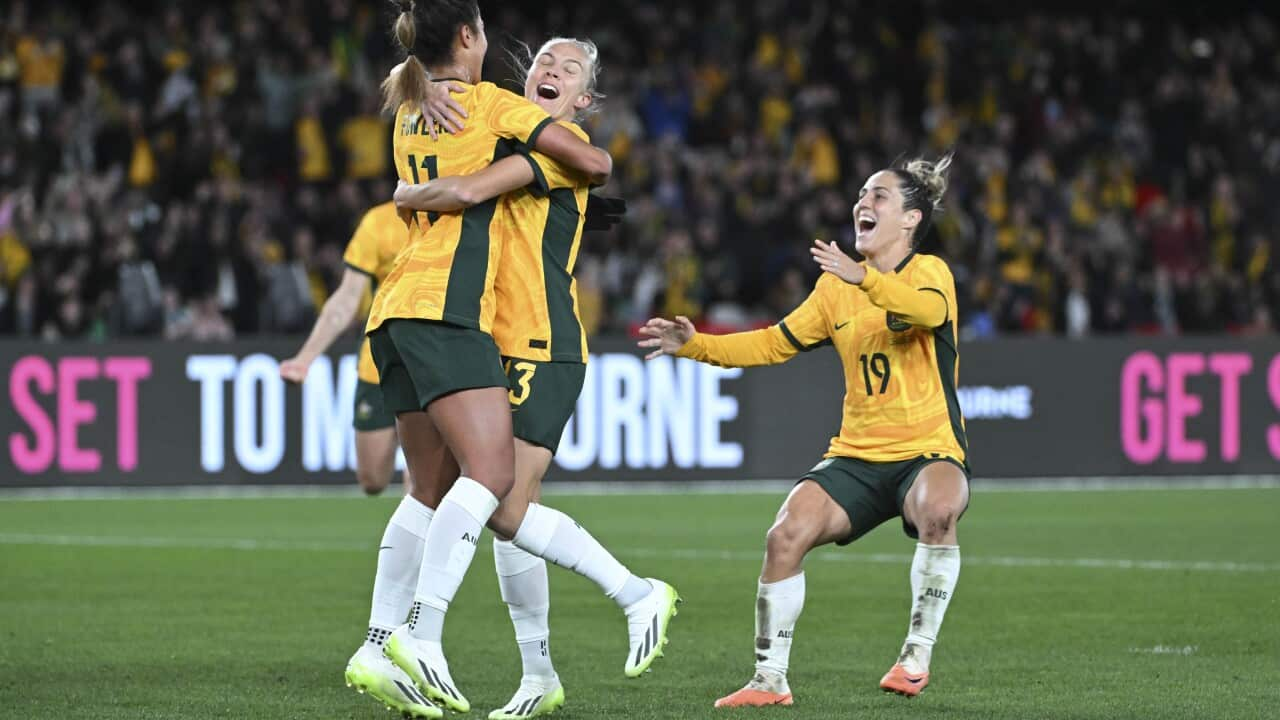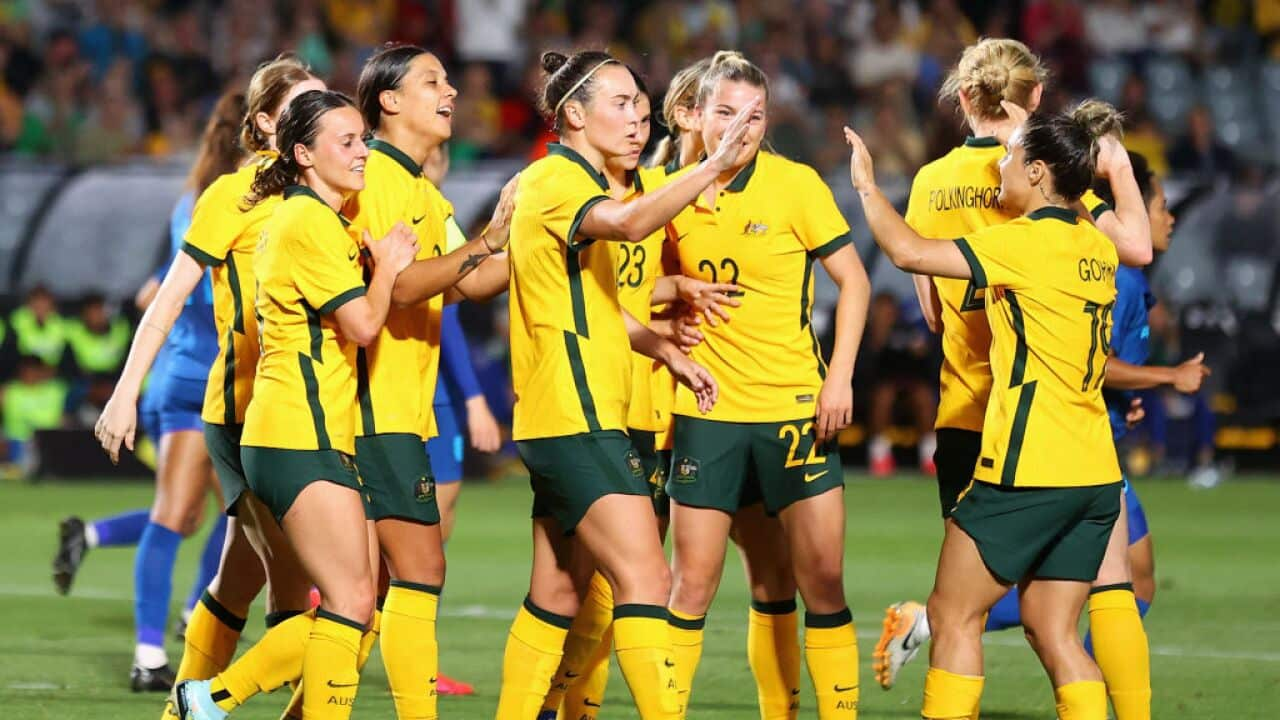On the the weekend before the FIFA Women's World Cup, about 350 female footballers across the ages of 10-and-under and also 50 years-and-over took part in the inaugural Lisa De Vanna Cup in Western Australia.
De Vanna is the second-highest Matildas goalscorer after Sam Kerr. Both hail from WA's capital, Perth.
That local connection is a source of inspiration for some young female footballers from the state.

Nike, a sponsor of both the Matildas and the Socceroos, says the Australian women’s team has sold more official jerseys in the lead-up to the Women's World Cup than the men's team did during and since the equivalent tournament last year. Source: AAP / James Ross
"The Matildas players didn't start where they are now. They also didn't have the opportunities that I have today as a girl playing football. It is good to see it is getting better and it is more inclusive and multicultural."
She has followed with particular interest the journeys of Matildas stars Sam Kerr and Ellie Carpenter, which spurred her hope of one day reaching the same heights.
"She [Sam Kerr] started playing at a local club when she was 12. She lived in Perth where I live. And she got all the way to being captain of the Matildas. It is very inspiring to see - that could be me one day."

Sienna says football is a big part of her life and it all started when she started filling in for her brother. "I used to fill in for my brother's teams a few times. And that just got me thinking: I really have a passion for this and want to keep going." Source: Supplied
'I just fell in love with it'
Sienna's teammate, 13-year-old Lily Whitehurst, also shares the dream of playing professionally, perhaps even as a future Matilda.
"The practice, the hard work, the dedication - that's what you need. And, hopefully, I have enough of what it takes," she told SBS News.
She said female football participation, and the facilities to support it, have come a long way since she started playing the game at the age of seven.

Lily Whitehurst says playing football when was younger was quite daunting, and she was often the only female trying out for the team. She says has gained invaluable life skills from playing football - from making friends to being more confident. "I wouldn't be as confident as I am, I wouldn't be as social as I am now, if wasn't for the people who were encouraging me," she said. Source: Supplied
"I used to play with the boys at school. And it just kind of started from there. I just fell in love with it. I even got my friends to start playing."
With tickets secured for two Women's World Cup matches, the die-hard Matildas fan is feeling the excitement.
"It's just going to be amazing and I'm sure that there'll be a lot of young girls turning up at the games very excited.
"The women's game is going to improve so much because of the support."
Refereeing some of the games for the two-day Lisa De Vanna Cup - which is also called the Festival of Community Soccer - was 14-year-old Caoimhe Steele, a midfielder for Perth SC.
She says football has always been a part of her life.

Caoimhe Steele says she has met Lisa De Vann and Sam Kerr, which greatly encouraged her to keep striving for the chance to go professional. "They are great role models to look up to," she said. Source: Supplied
Choosing a side to back in the upcoming Women's World Cup is a tough decision though, with the Matildas up against Ireland in the opening match.
"Controversially, because I am born in Ireland, I have to go for Ireland. But if Australia wins, good on them. I feel I can share in the win in any event."
'Mix of ages and energy'
The month-long Women's World Cup, co-hosted this year by Australia and New Zealand, begins on Wednesday 20 July. It's the first time the event has been held in the southern hemisphere and also a first for the Asia-Pacific region.
The organiser of the Lisa De Vanna Cup event, Jane Fraser, says the enthusiasm is already translating into increased participation in grassroots female football.
"We had over 350 players on the pitches. They aged in ranges from the under-tens to women in their fifties and sixties. It was just wonderful to see," she said.
"So you would just swivel from [watching the] under-tens and then you would see the open women's. I don't know of any other event that would have kind of mix of ages and energy happening in just one space."
She said the growth in female football participation numbers in recent years has accelerated - and the inaugural festival aimed to build on the momentum.
"The idea was to foster and encourage more young women and girls to play more football - to get into team sport and stay in a team sport. Team sports are very important from an exercise perspective and also for mental health.
"Football is the fastest rising, most popular sport in Australia. It's growing. It's very, very exciting."
Female football participation on the rise
After taking a hit during the pandemic, football participation numbers in Australia have recovered, seeing 8 per cent annual growth in 2022. That's just a small component of a 36 per cent increase over the last six years.
The increase flies in the face of a , commissioned by the Australian Sports Commission, which predicted participation in sports generally would drop to 10 per cent of the population by 2030.
Peter Vickers is the recently retired director of the specialist football program at the John Curtin College of the Arts in Perth.
He says over a 33-year period in the role he saw talented football players graduate from the program, including Lisa De Vanna.
"It's been a slow burn in some ways," he says, referring to the enrolment figures three decades ago.
"I remember the first year or two of our football program at John Curtin... girls were quite free to apply, but we didn't have any applications in those first years.
"Interestingly enough, one of the very early applicants was Tanya Oxtoby, the current Chelsea assistant coach who also is doing commentary for the Women's World Cup.
"Those opportunities have always been there for girls, but we're now seeing more of them grab that opportunity. They realise that there is a career path for female footballers, which probably wasn't quite so obvious in those very, very early days 30 years ago."
He says the goal is to get the current 70:30 split of male-to-female participation in community football closer to gender parity.
He adds that ensuring adequate provision of infrastructure and resources will be part of achieving any sustained growth in grassroots participation, which can then be translated into a talent pipeline for the professional leagues.
"When it comes to specific facilities for girls and for women, there is some progress being made but we need a lot more [investment in this area]."
Creating a legacy
Whether the tournament will result in sustained and permanent growth in grassroots female football is not a guaranteed outcome, according to Dr Michelle O'Shea, a researcher of gender and diversity in professional sports at Western Sydney University.
"I think we will see an uptick, but I think one of the issues is how do we retain those girls? How do we make sure that they move through the pathway? And really importantly, how they retain their involvement throughout the life course."
She said the as their male counterparts showed gender parity remains elusive.
"We're going to have up to 2 billion eyes on the Women's World Cup. We have in excess of 1.2 million tickets sold. And still the women only receive a quarter of what their male counterparts do (in prize money).
"They really need to pull the game up to the level that it ought to be - and that is investment, and that is prize money."
The Matildas are pioneers in calling for equal pay for female footballers.
In 2019, the player's union Professional Footballers Australia struck a collective bargaining agreement with Football Australia to see members of the Matildas paid the same salary as the men in the Socceroos.

Ellie Carpenter says she is proud to be part of the movement calling for professional female footballers to be remunerated and recognised in the same way as their male peers. In a collective statement released ahead of the Women's World Cup, the Matildas said they raised the issue of prize money because they "wanted to have a voice in something bigger than football". Source: AAP / James Ross
"I have been in that era where I have seen it go from zero to a hundred. I am honoured to be part of this change.
"We see prize money increased [by triple for this event] - but there is still a long way to go compared to the men.
"You see the numbers. You see sold-out games. This World Cup, it's going to be the biggest women's football tournament ever. And to be part of that, hopefully we can keep building on this because, for me, this is just the beginning."












